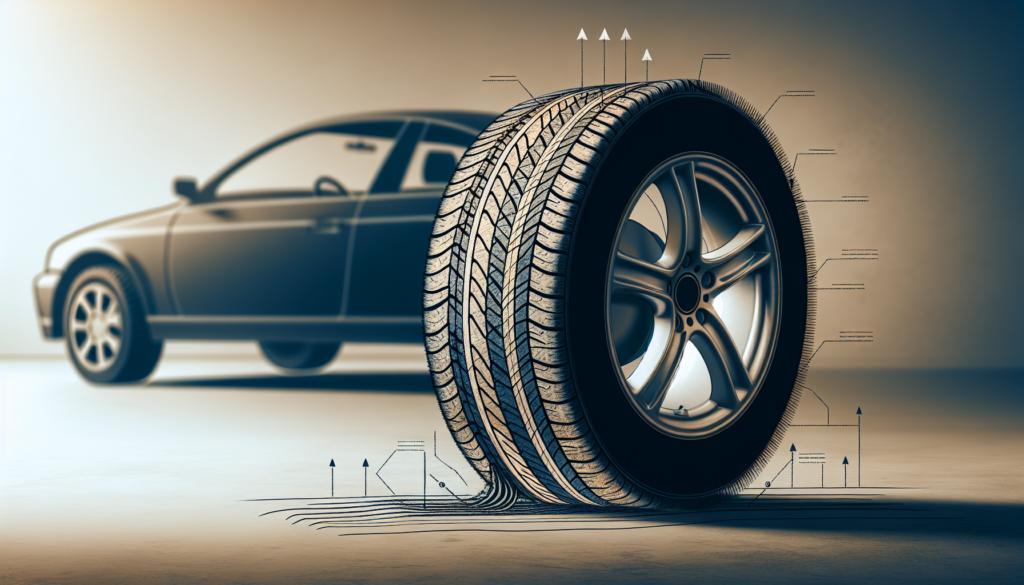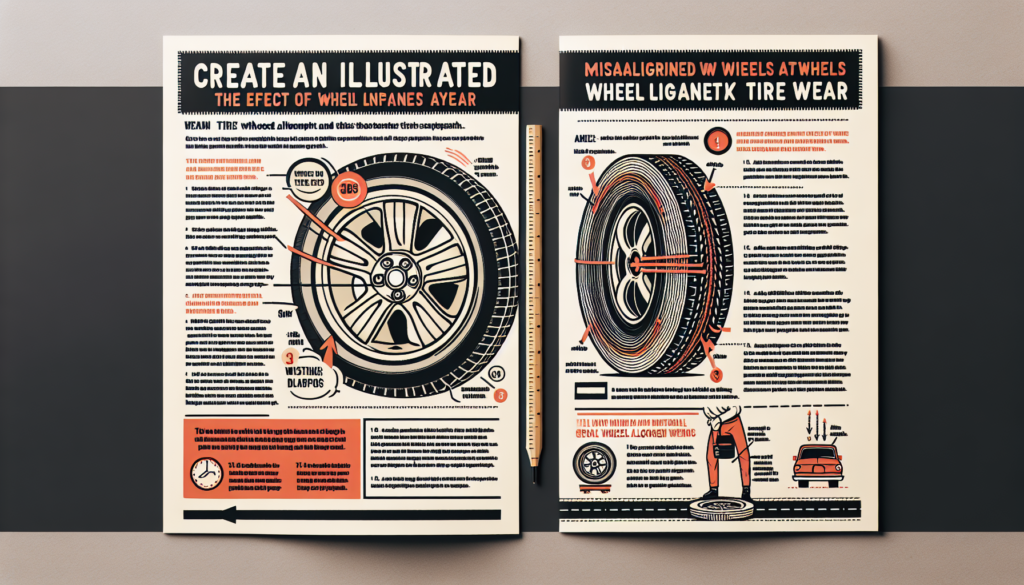You may be surprised to learn that improper wheel alignment can actually have a significant impact on tire wear. When your wheels are not properly aligned, it can cause uneven and premature wearing of your tires. This occurs because misalignment puts added pressure on certain parts of the tires, causing them to wear down faster in those areas. In turn, this can lead to a variety of issues, including decreased fuel efficiency, decreased traction and handling, and even an increased risk of blowouts. So, if you want to maximize the lifespan of your tires and maintain optimal vehicle performance, it’s important to ensure that your wheels are properly aligned.

Effects of Improper Wheel Alignment on Tire Wear
Proper wheel alignment is crucial for maintaining the longevity and performance of your tires. When your wheels are not aligned correctly, it can lead to various types of tire wear, ultimately impacting your driving experience and vehicle safety.
Uneven Tire Wear
One of the most common effects of improper wheel alignment is uneven tire wear. When your wheels are not aligned properly, some areas of the tire tread can experience more friction and wear than others. This can result in worn-out patches on the tire surface, creating an uneven pattern. Uneven tire wear not only compromises the aesthetics of your tires but also affects their overall performance.
Accelerated Tire Wear
Improper wheel alignment can also lead to accelerated tire wear. When your wheels are not aligned correctly, specific parts of the tire tread are subjected to excessive friction and pressure. This excessive wear and tear can cause the tires to wear out much faster than they should. Accelerated tire wear not only leads to premature tire replacement but also compromises the overall safety of your vehicle.
Increased Tread Wear
Another effect of improper wheel alignment is increased tread wear. The tread on your tires is essential for maintaining traction and grip on the road. When the wheels are misaligned, certain areas of the tread can wear down more quickly, reducing its depth. Decreased tread depth leads to reduced traction, especially on wet or slippery surfaces, increasing the risk of accidents.
Feathering
Feathering is a type of tire wear that occurs when the tread blocks on the tire begin to wear unevenly. One side of each tread block becomes more rounded, resembling the shape of a feather. This type of wear is often associated with improper wheel alignment, particularly excessive toe-in or toe-out alignment angles. Feathering can negatively affect the tire’s performance, leading to decreased stability and handling.
Camber Wear
Improper wheel alignment can also cause camber wear. Camber refers to the inward or outward tilt of the wheel when viewed from the front of the vehicle. When the camber angle is misaligned, it can cause one side of the tire to wear more than the other. Excessive positive or negative camber can lead to camber wear, resulting in uneven tire wear and reduced tire life.
Toe Wear
Toe wear is another form of tire wear caused by improper wheel alignment. Toe refers to the angle at which the tires point inward or outward when viewed from above. When the toe angle is misaligned, it can cause the tires to scrub against the road surface. This constant rubbing and friction can lead to accelerated toe wear, causing the tires to wear down unevenly and prematurely.
Caster Wear
Improper wheel alignment can also affect the caster angle, which refers to the forward or backward tilt of the steering axis when viewed from the side of the vehicle. When the caster angle is misaligned, it can result in caster wear. This type of wear typically occurs on one side of the tire, leading to uneven tire wear patterns and reduced tire life.
Shoulder Wear
Shoulder wear is a common type of tire wear that occurs on the outer edges of the tire. Improper wheel alignment, specifically excessive camber or too much toe-in, can cause excessive wear on the shoulders of the tires. Over time, this wear can cause the tire to become more prone to punctures and blowouts, compromising your safety on the road.
Inner and Outer Edge Wear
Improper wheel alignment can lead to inner and outer edge wear on the tires. This type of wear occurs when the edges of the tire tread wear down faster than the center portion. Inner and outer edge wear can be caused by various alignment issues, such as excessive camber, incorrect toe settings, or uneven caster angles. This type of wear affects the tire’s overall performance, reducing stability and compromising tread life.
Center Wear
Improper wheel alignment can also result in center wear on the tires. Center wear refers to excessive wear in the middle portion of the tread. This type of wear is commonly associated with over-inflation of the tires, but misalignment can exacerbate the issue. Center wear can lead to reduced traction and handling, compromising the tire’s ability to grip the road surface effectively.
Different Types of Tire Wear
Understanding the different types of tire wear is essential in identifying alignment issues and addressing them promptly. By recognizing the signs of specific wear patterns, you can take corrective measures to prevent further damage to your tires.
Tread Wear
Tread wear occurs when the grooves and patterns on the tire surface begin to wear down, primarily due to normal usage. Regular inspection of the tread depth is crucial for ensuring optimal traction and performance. Proper wheel alignment helps maintain even tread wear and extends the tire’s lifespan.
Sidewall Wear
Sidewall wear refers to the damage or wear on the sides of the tire. It can be caused by various factors, such as rubbing against curbs, potholes, or improper tire mounting. While improper wheel alignment may indirectly contribute to sidewall wear by affecting overall tire performance, it is not the primary cause.
Shoulder Wear
Shoulder wear typically occurs on the outer edges of the tires. It can be a result of improper wheel alignment, specifically excessive camber or toe-in. Shoulder wear compromises tire performance, affecting traction and stability on the road.
Edge Wear
Edge wear refers to the wearing down of the tire edges, including both the shoulder and inner edges. It can be caused by misalignment issues, such as excessive camber or incorrect toe settings. Edge wear not only reduces the tire’s lifespan but also affects handling and safety.
Center Wear
Center wear manifests as excessive wear in the middle portion of the tread. It can be caused by over-inflation or misalignment issues. Center wear compromises traction and handling, diminishing the tire’s ability to grip the road effectively.
Uneven Tire Wear
Uneven tire wear is a common consequence of improper wheel alignment, and it can have significant implications for your tires and the overall vehicle performance.
Causes of Uneven Tire Wear
Uneven tire wear can be caused by misaligned wheels. Factors such as toe misalignment, camber misalignment, and caster misalignment can all contribute to uneven tire wear. Additionally, worn suspension components or a lack of regular tire rotations can exacerbate the issue.
Effects of Uneven Tire Wear
Uneven tire wear negatively affects tire performance and longevity. It can lead to decreased traction, compromised handling, and increased risk of hydroplaning on wet surfaces. Uneven tire wear also necessitates more frequent tire replacements, resulting in increased expenses. Addressing wheel alignment issues promptly can prevent the detrimental effects of uneven tire wear.
Accelerated Tire Wear
Accelerated tire wear is another consequence of improper wheel alignment that can significantly impact the lifespan of your tires.
Causes of Accelerated Tire Wear
Improper wheel alignment, specifically toe misalignment, is a common cause of accelerated tire wear. When the toe angle is misaligned, the tires can scrub against the road surface, causing excessive friction and wear. Over time, this accelerated wear can lead to the need for premature tire replacement.
Effects of Accelerated Tire Wear
Accelerated tire wear compromises tire integrity and safety. Tires with excessive wear are more susceptible to blowouts, punctures, and reduced traction. Additionally, more frequent tire replacements result in increased costs for vehicle maintenance. Regular wheel alignment checks and adjustments can help mitigate the effects of accelerated tire wear.

Increased Tread Wear
Increased tread wear is a direct consequence of improper wheel alignment that affects the overall performance of your tires.
Causes of Increased Tread Wear
Improper wheel alignment, particularly toe misalignment, can cause increased tread wear. When the toe angle is misaligned, the tires tend to drag or scuff against the road surface, resulting in more extensive tread wear and reduced tread depth.
Effects of Increased Tread Wear
Increased tread wear significantly impacts tire performance and safety. Reduced tread depth compromises traction, especially on wet or slippery surfaces, increasing the risk of accidents. Additionally, tires with increased tread wear are more prone to punctures and blowouts, potentially leaving you stranded on the road. Proper wheel alignment is crucial for maintaining optimal tread wear and ensuring the longevity of your tires.
Feathering
Feathering is a specific type of tire wear that can occur due to improper wheel alignment.
Causes of Feathering
Feathering is often associated with excessive toe alignment angles. When the tires are misaligned, one side of each tread block becomes more rounded, resembling the shape of a feather. This uneven wear pattern can occur due to various alignment issues, such as toe-in or toe-out misalignment.
Effects of Feathering
Feathering affects tire performance and stability. The uneven wear pattern caused by feathering compromises the tire’s ability to maintain traction and handling. It can also lead to increased road noise and vibrations, further impacting the comfort of your drive. Regular wheel alignment checks can help prevent feathering and its detrimental effects on tire wear.

Camber Wear
Camber wear is a type of tire wear that can occur due to improper wheel alignment.
Causes of Camber Wear
Camber wear is typically caused by excessive positive or negative camber angles. When the wheels are misaligned, one side of the tire tread can wear down more quickly than the other, resulting in an uneven wear pattern. This misalignment can occur due to worn suspension components or improper adjustments during wheel alignment.
Effects of Camber Wear
Camber wear negatively affects tire performance and lifespan. The uneven wear pattern can lead to decreased traction and handling, compromising the vehicle’s stability on the road. Additionally, camber wear can result in the need for premature tire replacement, adding to your vehicle maintenance expenses. Regular wheel alignment and inspection can help prevent camber wear and its detrimental effects.
Toe Wear
Toe wear is a common type of tire wear that can occur due to improper wheel alignment.
Causes of Toe Wear
Toe wear is typically caused by misaligned toe angles. When the wheels are misaligned, the tires can scrub against the road surface, resulting in accelerated wear on the inner or outer edges. Misalignment issues, worn suspension components, or lack of regular wheel alignments can contribute to toe wear.
Effects of Toe Wear
Toe wear compromises tire performance and safety. Tires with toe wear have decreased traction and handling capabilities, particularly when cornering or driving on slippery surfaces. Additionally, excessive toe wear can lead to premature tire replacement, increasing your vehicle maintenance costs. Timely wheel alignment checks and adjustments can prevent toe wear and its detrimental effects.

Caster Wear
Caster wear is a specific type of tire wear that can occur due to improper wheel alignment.
Causes of Caster Wear
Caster wear typically occurs due to misaligned caster angles. When the wheels are misaligned, the tires can experience uneven wear patterns, primarily on one side of the tread. This misalignment can be caused by worn suspension components or improper adjustment during wheel alignment.
Effects of Caster Wear
Caster wear negatively affects tire performance and longevity. The uneven wear patterns can lead to decreased traction and handling, compromising the vehicle’s stability on the road. Additionally, caster wear can result in the need for premature tire replacement, adding to your vehicle maintenance expenses. Regular wheel alignment checks can help prevent caster wear and its detrimental effects on tire wear.
Conclusion
Proper wheel alignment is essential for maintaining optimal tire wear and overall vehicle performance. Improper alignment can result in various types of tire wear, including uneven wear, accelerated wear, increased tread wear, feathering, camber wear, toe wear, caster wear, shoulder wear, inner and outer edge wear, and center wear. Each type of tire wear has its own causes and effects, affecting traction, handling, stability, and tire lifespan.
Regular inspections and wheel alignments are crucial for identifying and correcting alignment issues promptly. By prioritizing proper wheel alignment, you can maximize the lifespan of your tires, ensure optimal performance, and enhance safety on the road.


